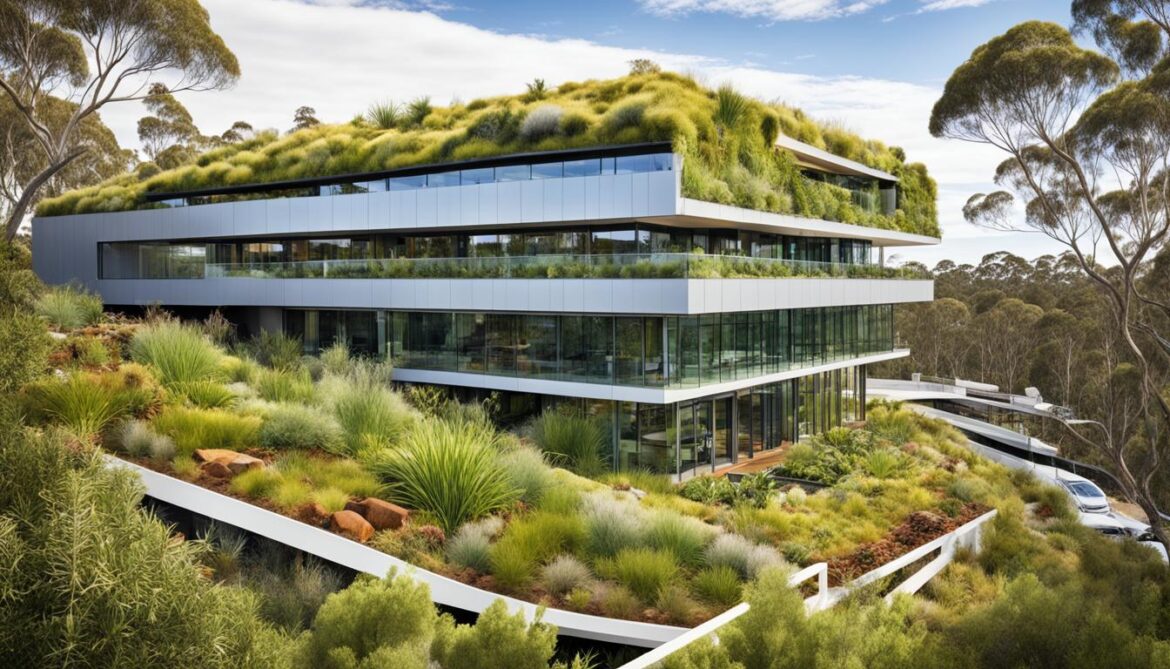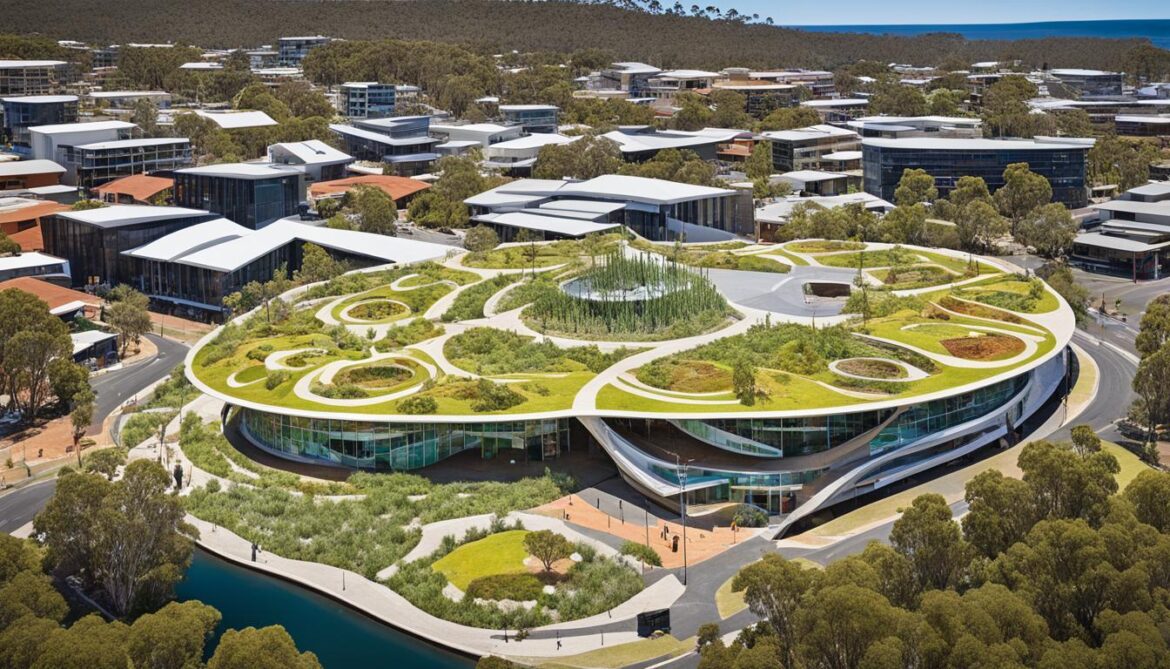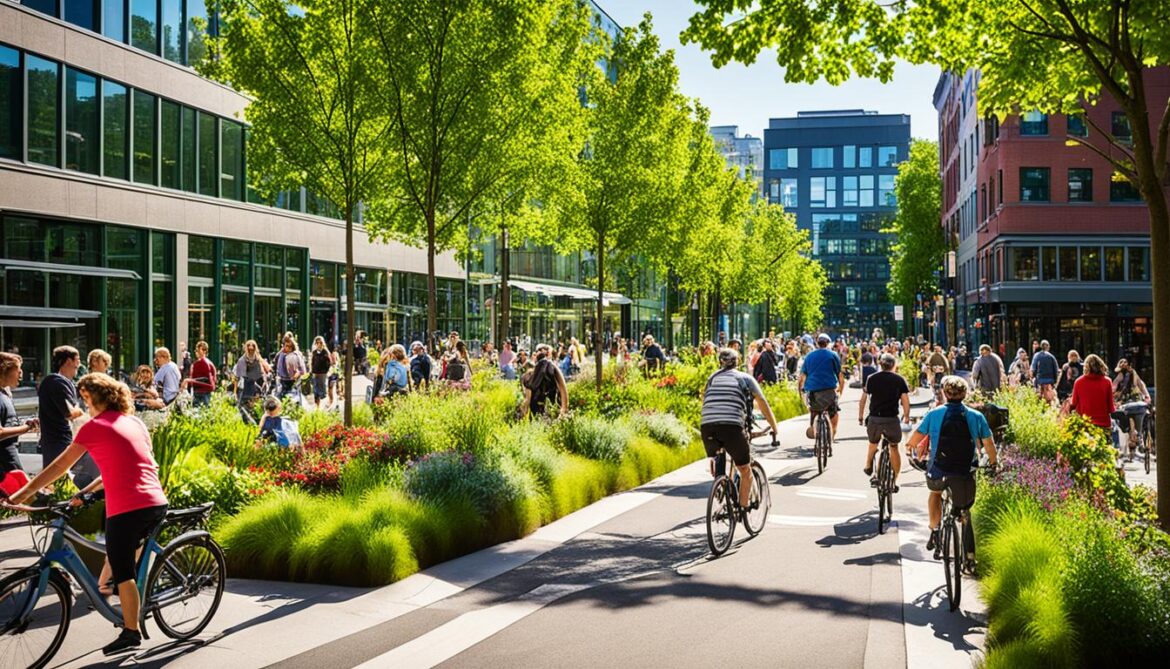Australia Biodiversity and the Built Environment
The preservation of Australia’s unique biodiversity is a pressing concern in the face of rapid urban development. As cities expand and habitats are lost, conservation efforts and ecological sustainability become paramount. Protecting wildlife and preserving native flora and fauna should be at the forefront of urban planning and design.
Key Takeaways:
- Australia’s built environment poses a threat to its biodiversity.
- Urban sprawl and land clearing are major causes of biodiversity loss.
- Green infrastructure plays a crucial role in conserving urban biodiversity.
- Eco-friendly architecture promotes sustainability and biodiversity preservation.
- Involving Indigenous communities enhances the environmental and social outcomes of urban development.
The Impact of Urban Sprawl on Biodiversity
Urban sprawl and farming have become major drivers of biodiversity loss in Australia. The expansion of urban areas and the clearing of land for agriculture have significantly impacted the country’s unique ecosystems and vulnerable species.
The consequences of urban sprawl and land clearing are particularly evident along the east coast and near major urban centers such as Brisbane, Cairns, Melbourne, and Sydney. These areas, once teeming with diverse flora and fauna, have experienced habitat fragmentation and destruction, leading to the decline of threatened species.
Fragmentation caused by urbanization disrupts natural habitats, isolating populations of plants and animals and reducing their ability to disperse and find suitable mates. Additionally, land clearing for infrastructure development and agriculture destroys important habitats and food sources, further exacerbating the negative impacts on biodiversity.
The introduction and spread of invasive species is another consequence of urban expansion. Invasive species, such as feral cats, foxes, and introduced plants, outcompete native species for resources and disrupt the balance of ecosystems. This often leads to the displacement or extinction of native species that are unable to adapt to the new threats.
Climate change also poses a significant threat to biodiversity in urban areas. Rising temperatures, changing rainfall patterns, and extreme weather events can negatively affect the survival and reproduction of many species. Urban areas, with their heat-absorbing infrastructure and limited green spaces, are particularly vulnerable to the impacts of climate change.
The Consequences of Urban Sprawl on Biodiversity
| Threats to Biodiversity | Description |
|---|---|
| Fragmentation | Urbanization disrupts natural habitats, isolating populations and limiting their ability to disperse and interact. |
| Land Clearing | Clearing land for urban development and agriculture destroys important habitats and food sources for native species. |
| Invasive Species | Urban expansion contributes to the introduction and spread of non-native species that outcompete native species. |
| Climate Change | Rising temperatures and extreme weather events pose significant challenges for urban biodiversity. |
The impacts of urban sprawl and its associated factors, including fragmentation, land clearing, invasive species, and climate change, have led to a rapid decline in biodiversity in Australia’s urban areas. Urgent action is needed to mitigate these threats and protect the unique flora and fauna that contribute to the country’s ecological heritage.
The Role of Green Infrastructure in Biodiversity Conservation
Green infrastructure, such as parks, gardens, and green spaces within cities, plays a crucial role in conserving urban biodiversity. It provides habitats for native flora and fauna and promotes ecological connectivity. Effective urban planning that incorporates green infrastructure can support habitats, create wildlife corridors, and limit the impacts of a warming climate on cities. Increasing the amount of green public space and managing green links and corridors within urban areas are essential strategies for preserving biodiversity.
Urban biodiversity is a vital component of ecological sustainability and the overall health of a city. Green infrastructure refers to the network of interconnected natural areas, including parks, gardens, wetlands, and green roofs, that are designed to mimic and integrate with natural ecosystems within urban environments. These green spaces provide a range of environmental, social, and economic benefits, contributing to the overall livability of cities.
One of the key benefits of green infrastructure is its ability to preserve habitats for native vegetation and wildlife. By incorporating native plants and trees into urban landscapes, green infrastructure provides food, shelter, and nesting opportunities for a wide range of species. This helps to maintain urban biodiversity and support populations of pollinators, birds, and other wildlife.
Another important function of green infrastructure is the promotion of ecological connectivity. Urbanization often leads to the fragmentation of natural habitats, isolating populations and restricting their movement. Green infrastructure helps to counteract this fragmentation by creating wildlife corridors and green links that connect different natural areas within the city. These corridors enable the movement of species, allowing them to access essential resources and establish new populations.
Effective urban planning is crucial for the successful implementation of green infrastructure. It involves identifying and protecting areas of high biodiversity value, integrating green spaces into urban development plans, and ensuring the preservation of existing native vegetation. Urban planners should consider factors such as connectivity, accessibility, and suitability of locations for green infrastructure. By incorporating these considerations, cities can create a network of green spaces that enhances biodiversity and strengthens ecological connectivity.
To illustrate the importance of green infrastructure in biodiversity conservation, here is an example of the impact of wildlife corridors within an urban area:

Table: Example of the impact of wildlife corridors within an urban area
| Species | No. of Individuals | No. of Species |
|---|---|---|
| Area with Wildlife Corridors | 100 | 20 |
| Area without Wildlife Corridors | 50 | 10 |
Source: Wildlife Conservation Society
In the above example, the presence of wildlife corridors in an urban area has resulted in a higher number of individuals and species compared to an area without wildlife corridors. This emphasizes the importance of ecological connectivity in supporting thriving urban biodiversity.
In conclusion, green infrastructure plays a critical role in preserving urban biodiversity. By providing habitats, promoting ecological connectivity, and mitigating the impacts of climate change, green infrastructure contributes to the overall sustainability and resilience of cities. Incorporating green infrastructure into urban planning and increasing the amount of green public space are essential for conserving biodiversity and creating healthier, more livable cities.
Building Sustainable and Eco-Friendly Architecture
Sustainable and eco-friendly architecture is a key component of the built environment that promotes biodiversity conservation. By prioritizing sustainable practices in design and construction, we can create buildings that minimize their environmental impact while supporting the well-being of both humans and the natural world.
When it comes to sustainable architecture, eco-friendly design principles are crucial. This involves utilizing energy-efficient materials, renewable resources, and environmentally friendly construction practices. By incorporating these elements into the building process, we can reduce carbon emissions, energy consumption, and waste generation.
Passive design plays a significant role in sustainable architecture. By maximizing natural lighting and ventilation, buildings can reduce their reliance on artificial lighting and climate control systems. This not only saves energy but also enhances occupant comfort and well-being. Carefully designed shading strategies and insulation materials can further enhance energy efficiency and minimize the need for mechanical cooling and heating systems.
“Sustainable architecture not only benefits the environment but also creates healthier indoor environments for occupants, improving overall well-being and productivity.”
Green certifications are instrumental in ensuring that buildings meet strict sustainability standards. Certifications such as LEED (Leadership in Energy and Environmental Design) and Green Star assess and recognize buildings that are designed, constructed, and operated with minimal impact on the environment. These certifications provide credibility and assurance that a building has been evaluated based on its energy efficiency, water conservation, use of renewable materials, and overall environmental performance.
Benefits of Sustainable Architecture:
- Promotes biodiversity conservation
- Reduces carbon emissions and energy consumption
- Minimizes waste generation and resource depletion
- Enhances occupant comfort and well-being
- Improves indoor air quality and reduces environmental pollutants
Case Study: Sustainable Architecture in Action
| Building | Sustainable Features | Green Certifications |
|---|---|---|
| Sydney Opera House |
|
|
| One Central Park, Sydney |
|
|

These case studies demonstrate how sustainable architecture can be successfully implemented, showcasing the incorporation of energy-efficient strategies, renewable materials, and green certifications. By adopting sustainable and eco-friendly principles in architecture, we can create buildings that harmoniously coexist with nature, conserve biodiversity, and contribute to a greener future for generations to come.
The Importance of Indigenous Involvement in Urban Development
Indigenous communities play a vital role in creating a socially and environmentally sustainable built environment. Their participation in urban development not only recognizes their cultural identity and land rights but also brings invaluable Indigenous knowledge systems to the table. By incorporating this knowledge, urban planning can lead to better environmental and social outcomes.
Efforts have been made to partner with Indigenous communities and empower their rights and interests. However, these initiatives are still limited in scope. To truly harness the power of Indigenous knowledge and achieve meaningful collaboration, it is crucial to establish genuine partnerships built on trust, respect, and shared decision-making.
“When Indigenous communities are involved in urban planning, it allows us to maintain our cultural connection to the land and ensure that our voices are heard. Our knowledge of the land and its resources can contribute to sustainable development and benefit all community members.” – Samara Johnson, Indigenous Land Rights Activist
Recognizing Indigenous communities as key stakeholders in urban development is not only a matter of empowerment but also crucial for fostering inclusivity and ensuring the preservation of Indigenous cultural heritage. By actively involving Indigenous communities, urban planners can create spaces that are respectful, inclusive, and reflective of the diverse cultural identities that make up Australia’s social fabric.
Indigenous involvement in urban planning provides an opportunity to strengthen the connection between people and place. By incorporating Indigenous perspectives, practices, and values, we can create a built environment that respects and celebrates the unique relationship between Indigenous peoples and their land.
Additionally, Indigenous involvement in urban development contributes to the wider recognition of Indigenous intellectual and cultural property rights. By valuing Indigenous knowledge, we can challenge the historical marginalization and appropriation of Indigenous cultural heritage in urban spaces.
Ultimately, fostering meaningful partnerships with Indigenous communities in urban development is not only a necessary step towards social and environmental sustainability but also an important act of reconciliation and respect. It is an opportunity to learn from and collaborate with the custodians of this land, promoting a more inclusive, equitable, and culturally rich built environment.

| Benefits of Indigenous Involvement in Urban Development | Barriers to Indigenous Involvement in Urban Development |
|---|---|
|
|
Improving Walkability and Active Transportation in Cities
Enhancing walkability in cities is key to promoting active transportation and improving overall urban livability. By designing pedestrian-friendly neighbourhoods with well-connected streets and easy access to public transport services, cities can encourage residents to walk or cycle as their preferred modes of transport. This not only contributes to better health outcomes but also reduces car dependence and the associated environmental impacts.
Pedestrian-Friendly Design
Creating pedestrian-friendly urban spaces involves prioritizing the needs and safety of people on foot. Sidewalks and footpaths should be well-maintained, wide, and accessible, ensuring a comfortable walking experience for individuals of all ages and abilities. Implementing traffic calming measures, such as reducing speed limits, installing crosswalks, and adding pedestrian signals, helps to enhance safety and promote the use of active transportation.
Quality Public Transport
A robust and reliable public transport system is crucial for encouraging active transportation. By providing convenient access to buses, trams, trains, and other forms of public transit, cities can offer residents attractive alternatives to private vehicle use. Integrated transport networks with well-connected routes and frequent services make it easier for people to reach their destinations without relying on cars, while reducing traffic congestion and improving air quality.
Cycling Infrastructure
Investing in dedicated cycling infrastructure is another important aspect of creating walkable and bike-friendly cities. Designated bike lanes, cycle tracks, and shared paths ensure the safety and convenience of cyclists, encouraging more people to take up cycling as a means of transportation. Providing secure bike parking facilities, bike-sharing programs, and promoting a culture of cycling further encourage active transportation and contribute to a healthier and more sustainable urban environment.
“By prioritizing walkability and active transportation in our cities, we can create more vibrant and liveable communities, reduce air pollution, and improve public health.” – Jane Goodall

Improving walkability and promoting active transportation not only benefits the individuals who choose to walk or cycle but also has broader positive effects for the entire community. By designing neighbourhoods that prioritize pedestrians and provide well-connected streets, access to public transport, and dedicated cycling infrastructure, cities can foster a healthier, more sustainable, and more enjoyable urban environment for all residents.
The Benefits of Green Space for Health and Well-being
Access to green space, including public parks, nature reserves, and green areas within cities, has significant benefits for physical and mental health. Spending time in natural environments is associated with higher levels of self-reported good health and well-being.
Green space promotes physical activity, reducing sedentary behavior and encouraging people to engage in outdoor exercises such as walking, jogging, or cycling. These activities contribute to better cardiovascular fitness, improved muscle strength, and weight management. They also reduce the risk of chronic diseases such as obesity, diabetes, and heart disease.
Moreover, spending time in nature has positive effects on mental health. Research has shown that exposure to green spaces can reduce psychological distress, alleviate symptoms of depression and anxiety, and enhance overall well-being. The soothing and calming effects of nature help to reduce stress levels and promote relaxation.
“Nature is essential for me, whenever I feel overwhelmed, I take a walk in the nearby park. It’s like pressing a reset button for my mind.” – Sarah Smith, Nature Enthusiast
Green spaces also provide opportunities for community connections and social interactions. People who visit parks or engage in outdoor activities often have the chance to meet others, form relationships, and build a sense of belonging. This sense of community contributes to social cohesion and creates a support network that improves mental well-being.
Furthermore, green spaces play a vital role in biodiversity conservation. By preserving natural habitats and ecosystems, they provide homes for a diverse range of plant and animal species. Biodiversity is crucial for maintaining the balance of ecosystems and ensuring the stability of our natural environment.
Lastly, green spaces contribute to improving air quality in urban areas. Trees and plants absorb pollutants and release oxygen, helping to filter and cleanse the air. This is particularly important in cities, where air pollution can have detrimental effects on human health. Green spaces act as natural air purifiers, creating a healthier and more pleasant living environment for residents.

| Benefits of Green Space for Health and Well-being | Description |
|---|---|
| Physical Activity | Green space promotes physical activity, reducing sedentary behavior and encouraging outdoor exercises such as walking, jogging, or cycling. |
| Mental Health | Spending time in nature reduces psychological distress, alleviates symptoms of depression and anxiety, and enhances overall well-being. |
| Community Connections | Green spaces provide opportunities for social interactions, forming relationships, and building a sense of community. |
| Biodiversity | Preserving natural habitats in green spaces contributes to biodiversity conservation. |
| Air Quality | Green spaces act as natural air purifiers, helping to filter and cleanse the air in urban areas. |
Sustainable Transport Systems and Health
A well-planned and sustainable transport system is crucial for promoting health in the built environment. It plays a significant role in shaping our daily lives and influencing physical activity levels, air quality, and overall well-being.
Active travel, such as walking and cycling, is an essential component of sustainable transport systems. By choosing to walk or cycle instead of using private vehicles, individuals can incorporate physical activity into their daily routines, which can have a positive impact on their health. Regular physical activity reduces the risk of chronic diseases, improves cardiovascular health, and supports mental well-being.
However, transport systems also present challenges that can affect health. Traffic accidents are a significant concern, especially in densely populated areas. Measures should be in place to ensure pedestrian and cyclist safety through the implementation of dedicated lanes, traffic calming measures, and improved infrastructure.
“Promoting active travel not only benefits our health but also contributes to creating more sustainable and livable cities.”
Sedentary behavior is another issue associated with transport systems. Long commutes in private vehicles or public transportation often involve extended periods of sitting, which can have detrimental effects on physical health. Encouraging active modes of transport can help reduce sedentary behavior and increase physical activity levels, leading to improved health outcomes.
In addition to physical activity concerns, transport systems contribute to air pollution, particularly in urban areas. Road transport is a significant source of air pollutants, which can have adverse effects on respiratory health and overall air quality. Implementing strategies to reduce emissions, such as promoting electric vehicles, improving public transport systems, and encouraging active modes of travel, can help mitigate these impacts.

The Benefits of Sustainable Transport Systems
The implementation of sustainable transport systems brings numerous benefits to individuals and communities:
- Improved air quality: By reducing reliance on fossil fuel-powered vehicles and promoting alternative modes of transport, sustainable transport systems contribute to cleaner air and create healthier environments for everyone.
- Enhanced accessibility: Well-designed transport systems that prioritize active travel modes and public transportation improve accessibility for all individuals, regardless of their mobility status, and reduce social inequalities.
- Traffic congestion reduction: Active travel modes and efficient public transportation systems can help alleviate traffic congestion, leading to smoother traffic flows and shorter travel times for commuters.
- Promotion of social connections: Sustainable transport systems encourage social interactions and community engagement by providing opportunities for shared spaces, such as cycling paths and pedestrian-friendly zones, fostering a sense of belonging and community well-being.
- Environmental sustainability: By reducing greenhouse gas emissions and promoting eco-friendly transportation options, sustainable transport systems contribute to mitigating climate change and protecting the environment.
Designing transport systems that prioritize active travel, pedestrian safety, and reduced emissions can positively influence human health and create more sustainable and livable cities.
Conclusion
Effective urban planning strategies are essential for achieving a balance between urban development and biodiversity conservation in Australia. By incorporating sustainable architecture, green infrastructure, Indigenous involvement, and promoting walkability and access to green spaces, cities can support thriving ecosystems and preserve the country’s rich biodiversity.
Sustainable architecture plays a vital role in minimizing the environmental impacts of buildings and promotes the use of energy-efficient materials and renewable resources. Integrating green infrastructure, such as parks and wildlife corridors, within urban areas provides habitats for native flora and fauna, while also enhancing ecological connectivity.
It is crucial to recognize and involve Indigenous communities in urban development. By incorporating Indigenous knowledge systems and partnering with these communities, urban planning can respect cultural identities, protect land rights, and contribute to positive environmental and social outcomes.
Prioritizing walkability and sustainable transport options not only promotes physical activity and reduces emissions but also improves overall urban livability. Creating well-designed pedestrian-friendly neighborhoods and cycling infrastructure, along with efficient public transport systems, encourages active travel and healthier lifestyles for residents.
By prioritizing the preservation of biodiversity, incorporating sustainable architecture, involving Indigenous communities, improving walkability, and creating green spaces, Australia can build cities that harmoniously coexist with the natural environment and contribute to a sustainable future.







